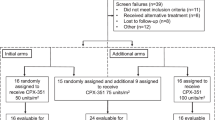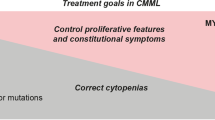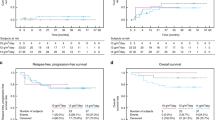Abstract
Because cladribine can increase cytarabine triphosphate levels, we tested a cladribine–cytarabine combination in the St Jude AML97, trial in which this combination was administered before standard chemotherapy to 96 children with acute myeloid leukemia (AML) or myelodysplastic syndrome. Patients received a 5-day course of cladribine (9 mg/m2 per dose) and cytarabine either as daily 2-h infusions (500 mg/m2 per dose) (arm A) or a continuous infusion (500 mg/m2 per day) (arm B). Ara-CTP levels and inhibition of DNA synthesis increased from day 1 to day 2, but were not different between the two arms. In addition, the median blast percentages at day 15 did not differ between arms A and B, but patients treated in arm A had shorter intervals between the initiation of the first and second courses of therapy. Thus, although there were trends toward better complete remission rates and overall survival for patients treated in arm B, the reduced efficacy of arm A may have been partially compensated by more intense timing of therapy for that group. For all patients, 5-year event-free survival and overall survival estimates were 44.1±5.4 and 50.0±5.5%. Our results suggest that cladribine in combination with continuous-infusion cytarabine is effective therapy for childhood AML.
This is a preview of subscription content, access via your institution
Access options
Subscribe to this journal
Receive 12 print issues and online access
$259.00 per year
only $21.58 per issue
Buy this article
- Purchase on Springer Link
- Instant access to full article PDF
Prices may be subject to local taxes which are calculated during checkout


Similar content being viewed by others
References
Creutzig U, Zimmermann M, Lehrnbecher T, Graf N, Hermann J, Niemeyer CM et al. Less toxicity by optimizing chemotherapy, but not by addition of granulocyte colony-stimulating factor in children and adolescents with acute myeloid leukemia: results of AML-BFM 98. J Clin Oncol 2006; 24: 4499–4506.
Lange BJ, Smith FO, Feusner J, Barnard DR, Dinndorf P, Feig S et al. Outcomes in CCG-2961, a children's oncology group phase 3 trial for untreated pediatric acute myeloid leukemia: a report from the Children's Oncology Group. Blood 2008; 111: 1044–1053.
Kaspers GJ, Creutzig U . Pediatric acute myeloid leukemia: international progress and future directions. Leukemia 2005; 19: 2025–2029.
Carrera CJ, Terai C, Lotz M, Curd JG, Piro LD, Beutler E et al. Potent toxicity of 2-chlorodeoxyadenosine toward human monocytes in vitro and in vivo. A novel approach to immunosuppressive therapy. J Clin Invest 1990; 86: 1480–1488.
Robertson LE, Chubb S, Meyn RE, Story M, Ford R, Hittelman WN et al. Induction of apoptotic cell death in chronic lymphocytic leukemia by 2- chloro-2′-deoxyadenosine and 9-beta-D-arabinosyl-2-fluoroadenine. Blood 1993; 81: 143–150.
Santana VM, Mirro Jr J, Harwood FC, Cherrie J, Schell M, Kalwinsky D et al. A phase I clinical trial of 2-chlorodeoxyadenosine in pediatric patients with acute leukemia. J Clin Oncol 1991; 9: 416–422.
Santana VM, Mirro Jr J, Kearns C, Schell MJ, Crom W, Blakley RL . 2-Chlorodeoxyadenosine produces a high rate of complete hematologic remission in relapsed acute myeloid leukemia. J Clin Oncol 1992; 10: 364–370.
Santana VM, Hurwitz CA, Blakley RL, Crom WR, Luo X, Roberts WM et al. Complete hematologic remissions induced by 2-chlorodeoxyadenosine in children with newly diagnosed acute myeloid leukemia. Blood 1994; 84: 1237–1242.
Krance RA, Hurwitz CA, Head DR, Raimondi SC, Behm FG, Crews KR et al. Experience with 2-chlorodeoxyadenosine in previously untreated children with newly diagnosed acute myeloid leukemia and myelodysplastic diseases. J Clin Oncol 2001; 19: 2804–2811.
Gandhi V, Estey E, Keating MJ, Chucrallah A, Plunkett W . Chlorodeoxyadenosine and arabinosylcytosine in patients with acute myelogenous leukemia: pharmacokinetic, pharmacodynamic, and molecular interactions. Blood 1996; 87: 256–264.
Kornblau SM, Gandhi V, Andreeff HM, Beran M, Kantarjian HM, Koller CA et al. Clinical and laboratory studies of 2-chlorodeoxyadenosine±cytosine arabinoside for relapsed or refractory acute myelogenous leukemia in adults. Leukemia 1996; 10: 1563–1569.
Robak T, Wrzesien-Kus A, Lech-Maranda E, Kowal M, Dmoszynska A . Combination regimen of cladribine (2-chlorodeoxyadenosine), cytarabine and G-CSF (CLAG) as induction therapy for patients with relapsed or refractory acute myeloid leukemia. Leuk Lymphoma 2000; 39: 121–129.
Rubnitz JE, Razzouk BI, Srivastava DK, Pui CH, Ribeiro RC, Santana VM . Phase II trial of cladribine and cytarabine in relapsed or refractory myeloid malignancies. Leuk Res 2004; 28: 349–352.
Crews KR, Gandhi V, Srivastava DK, Razzouk BI, Tong X, Behm FG et al. Interim comparison of a continuous infusion versus a short daily infusion of cytarabine given in combination with cladribine for pediatric acute myeloid leukemia. J Clin Oncol 2002; 20: 4217–4224.
Coustan-Smith E, Ribeiro RC, Rubnitz JE, Razzouk BI, Pui CH, Pounds S et al. Clinical significance of residual disease during treatment in childhood acute myeloid leukaemia. Br J Haematol 2003; 123: 243–252.
Becton D, Dahl GV, Ravindranath Y, Chang MN, Behm FG, Raimondi SC et al. Randomized use of cyclosporin A (CsA) to modulate P-glycoprotein in children with AML in remission: Pediatric Oncology Group Study 9421. Blood 2006; 107: 1315–1324.
Stevens RF, Hann IM, Wheatley K, Gray RG . Marked improvements in outcome with chemotherapy alone in paediatric acute myeloid leukemia: results of the United Kingdom Medical Research Council's 10th AML trial. MRC Childhood Leukaemia Working Party. Br J Haematol 1998; 101: 130–140.
Gibson BE, Wheatley K, Hann IM, Stevens RF, Webb D, Hills RK et al. Treatment strategy and long-term results in paediatric patients treated in consecutive UK AML trials. Leukemia 2005; 19: 2130–2138.
Lie SO, Abrahamsson J, Clausen N, Forestier E, Hasle H, Hovi L et al. Treatment stratification based on initial in vivo response in acute myeloid leukaemia in children without Down's syndrome: results of NOPHO-AML trials. Br J Haematol 2003; 122: 217–225.
Sung L, Lange BJ, Gerbing RB, Alonzo TA, Feusner J . Microbiologically documented infections and infection-related mortality in children with acute myeloid leukemia. Blood 2007; 110: 3532–3539.
Lehrnbecher T, Varwig D, Kaiser J, Reinhardt D, Klingebiel T, Creutzig U . Infectious complications in pediatric acute myeloid leukemia: analysis of the prospective multi-institutional clinical trial AML-BFM 93. Leukemia 2004; 18: 72–77.
Creutzig U, Zimmermann M, Reinhardt D, Dworzak M, Stary J, Lehrnbecher T . Early deaths and treatment-related mortality in children undergoing therapy for acute myeloid leukemia: analysis of the multicenter clinical trials AML-BFM 93 and AML-BFM 98. J Clin Oncol 2004; 22: 4384–4393.
Kurt B, Flynn P, Shenep JL, Pounds S, Lensing S, Ribeiro RC et al. Prophylactic antibiotics reduce morbidity due to septicemia during intensive treatment for pediatric acute myeloid leukemia. Cancer 2008; 113: 376–382.
Acknowledgements
We thank Vani Shanker for expert editorial review. This work was supported in part by Cancer Center Support (CORE) grant P30 CA-21765 from the National Institutes of Health, by a Center of Excellence Grant from the State of Tennessee and by the American Lebanese Syrian Associated Charities (ALSAC). C-H Pui is an American Cancer Society professor.
Author information
Authors and Affiliations
Corresponding author
Rights and permissions
About this article
Cite this article
Rubnitz, J., Crews, K., Pounds, S. et al. Combination of cladribine and cytarabine is effective for childhood acute myeloid leukemia: results of the St Jude AML97 trial. Leukemia 23, 1410–1416 (2009). https://doi.org/10.1038/leu.2009.30
Received:
Revised:
Accepted:
Published:
Issue Date:
DOI: https://doi.org/10.1038/leu.2009.30
Keywords
This article is cited by
-
Safety and efficacy of cladribine in multiple sclerosis: a systematic review and meta-analysis
Neurological Sciences (2023)
-
Re-induction with modified CLAG regimen in relapsed or refractory acute myeloid leukemia in children bridging to allogeneic hematopoietic stem cell transplantation
World Journal of Pediatrics (2020)
-
Role of minimal residual disease in the management of acute myeloid leukemia—a case-based discussion
Annals of Hematology (2018)
-
Polymorphisms at microRNA binding sites of Ara-C and anthracyclines-metabolic pathway genes are associated with outcome of acute myeloid leukemia patients
Journal of Translational Medicine (2017)
-
Antibiotic prophylaxis with teicoplanin on alternate days reduces rate of viridans sepsis and febrile neutropenia in pediatric patients with acute myeloid leukemia
Annals of Hematology (2017)



